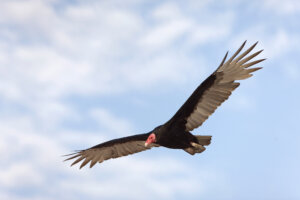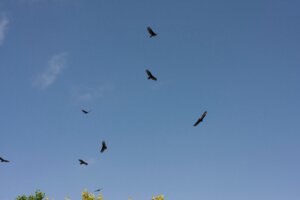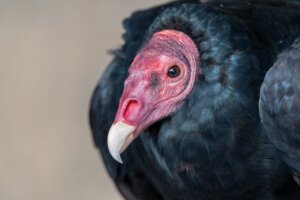The Valiant Vulture
August 13, 2025
By: Steve Dishman, Park Interpreter
“Look! Up in the Sky!”

While not technically superheroes, these soaring raptors have some pretty super adaptations to their unique role in our ecosystems!
Turkey vultures hold a special spot in the food web because they are scavengers. They feed nearly entirely on carrion or dead animal matter. This special role is important because they clear away potential diseases and do a lot to “clean up” dead animals, including roadkill. Vultures, unlike most raptors, will find their food sources primarily by smell, flying lower to the ground to pick up scents. They will generally be found on the ground near roadsides or bodies of water. Turkey vultures are the only species of vulture usually seen in Michigan. The related black vulture is found further south of our state.
Turkey vultures are larger than crows, so they are the most dominant scavengers around. You may notice their heads lack feathers, which is vital because of the number of insects that collect on carrion- no feathers means it’s easier to keep their heads and faces clean and clear! To further protect them from any pathogens in their decomposing diet, they have extra-strength stomach acid. Vultures also have some helpful habits that might seem pretty unpleasant to predators (and to humans reading about these birds!) While vultures look like they might be starring in a horror film, they actually don’t have many ways to actively defend themselves, especially when they’re feeding on the ground. To ward off potential dangers, they will vomit a smelly substance. In hot weather, they’ll urinate on their own feet and legs to cool down.
Another fantastic feature of vultures is their remarkable flying skill. On the ground, vultures are move awkwardly and they take a lot of effort to start flying. But once they’re airborne, turkey vultures soar to great heights, harnessing the wind to great advantage. You may see a large group of vultures soaring together. The secret to their soaring is in the shape they hold their wings. The V-shape allows rising warm air currents called thermals to collect under their wings allowing a vulture to move up and down and in circles without expending much energy.

Because of Michigan winters’ freezing temperatures, turkey vultures migrate from Michigan to the southern United States in the winter. Huge groups of turkey vultures can sometimes be observed during the Detroit River Hawk Watch period (September 1 – November 30 each year) over Lake Erie Metropark and the Detroit River. Along with other migrating raptors, turkey vultures head for warmer winter climates where their food won’t freeze. The Detroit River is a piece of a migratory corridor that birds utilize to make their long journeys southward a little bit easier. In mid-October, large numbers can be observed moving through the sky when the weather conditions cooperate. Come late February or early March, vultures return to Michigan again. Because of their annual migration, they are protected under the Migratory Bird Treaty Act.
So, when you see a turkey vulture or group of vultures circling above, remember the great services provided by our avian “cleanup crew” and enjoy their remarkable soaring skills.
Resources and events:
Hawk Fest at Lake Erie Metropark – September 20 and 21, 2025 (10 a.m. – 5 p.m. each day)

